INTERVIEW WITH ASHLEY STOKOLS
by GIselle Torres
26/3/2024
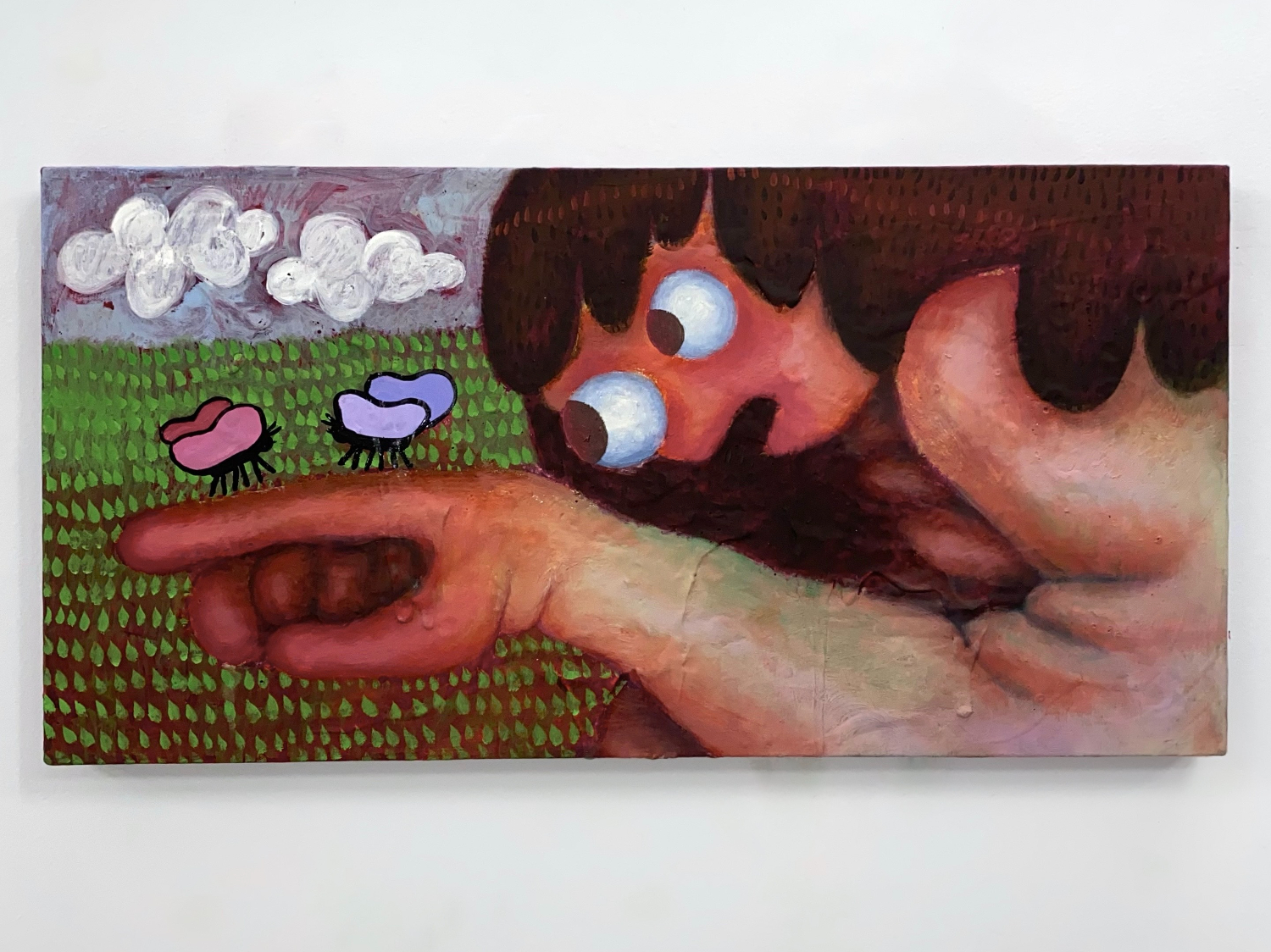
Giselle Torres: When did you know that you wanted to be an artist? Where did you start out and where has that taken you now?
Ashley Stokols: Well, it has kinda been the only thing I've ever been good at [Laughs]. And I mean, everyone has feelings that they want to get out and I was just kinda good at painting. I don’t come from a family of artists. I took art classes in highschool and I just kept painting and I have only ever painted. I feel like a lot of the artists I have been meeting have always been surrounded by art and artists and come from an art world in their immediate families. I feel like I have a totally different perspective from them. Like, you know, there’s materialists and there are dualists, but as far as art goes, I am science-brained. By that, I mean that I am less interested in spiritual and soul stuff and more-so I am interested in the literal and the physical.
GT: What are the themes and ideas that you are communicating through your work?
AS: Yes, the work is about me. I am really interested in symbology because you can take that one symbol and spin it to do a lot of things, and it evolves and takes meaning that is separate from where it was originally born. Also, repetition is nice. My paintings are often sarcastically funny because there is a dry, dark humor about them. They are not quite depressing, they just aren't earnest all-the-way. If people read them as ‘only sad’ it kind of makes me uncomfortable and if people read them as ‘only happy’ I don’t have a great response to that either. I want to communicate that they are kind-of-funny and kind-of-sad, because they both exist at the same time. It is hard for me to look at anything that is sad and not see a little humor in it—or vice versa. That could just be a flaw about the way I look at the world through irony, but at least I am making honest, genuine work about how I am disingenuous [Laughs].
Ashley Stokols: Well, it has kinda been the only thing I've ever been good at [Laughs]. And I mean, everyone has feelings that they want to get out and I was just kinda good at painting. I don’t come from a family of artists. I took art classes in highschool and I just kept painting and I have only ever painted. I feel like a lot of the artists I have been meeting have always been surrounded by art and artists and come from an art world in their immediate families. I feel like I have a totally different perspective from them. Like, you know, there’s materialists and there are dualists, but as far as art goes, I am science-brained. By that, I mean that I am less interested in spiritual and soul stuff and more-so I am interested in the literal and the physical.
GT: What are the themes and ideas that you are communicating through your work?
AS: Yes, the work is about me. I am really interested in symbology because you can take that one symbol and spin it to do a lot of things, and it evolves and takes meaning that is separate from where it was originally born. Also, repetition is nice. My paintings are often sarcastically funny because there is a dry, dark humor about them. They are not quite depressing, they just aren't earnest all-the-way. If people read them as ‘only sad’ it kind of makes me uncomfortable and if people read them as ‘only happy’ I don’t have a great response to that either. I want to communicate that they are kind-of-funny and kind-of-sad, because they both exist at the same time. It is hard for me to look at anything that is sad and not see a little humor in it—or vice versa. That could just be a flaw about the way I look at the world through irony, but at least I am making honest, genuine work about how I am disingenuous [Laughs].
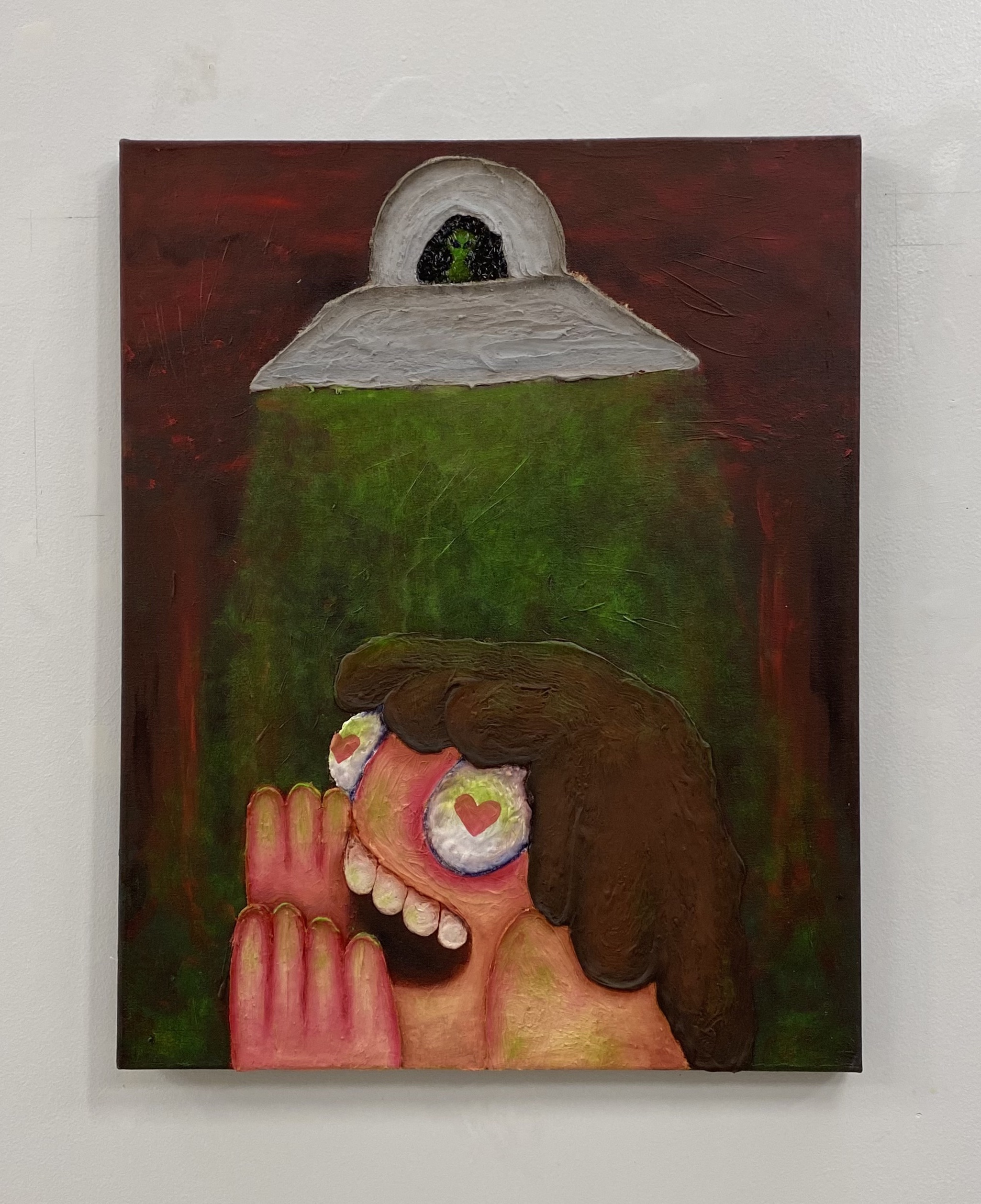

AS: One of them is minks. The idea started from a really early painting that I made about my Grandma’s mink being passed down to me. The mink felt like a potent symbol for a predestined fate, tradition, and marriage. A mink is born and bred to be killed, and in that I see some parallels to being a woman. There are patriarchal and societal aspects of being a woman and there’s also hormonal and biological aspects where it feels like you are born to do one thing.
I have done one painting with the mink where it was called, “Mink Vivisection” and I thought it was kind of funny to dissect something that isn’t alive. I thought of it like a representation of digging into your past or childhood only to find that there is nothing there. In a more recent one, I’m dissecting a frog. There are googly eyes on the hands and it evokes a brainless creature in a Pan’s Labyrinth kind of way [Laughs]. Where they are dissecting just because it is the thing to do. They are just disembodied dissectors who are thoughtlessly looking inward for no reason because there is nothing there.
Also, I find the idea of childbirth and of being a mother to be very scary. Being pregnant and giving birth is not pleasant in many ways… but the body produces hormones so that you forget the pain and want to do it again. It feels like a very out-of-control experience because you don’t know if what you are feeling is real or biologically produced. But… I am a materialist, and all feelings are feelings regardless and there is no way to make those separations between a real feeling and a biologically-produced one. So, that is where the mink started and I have just kept painting the mink… and sometimes in my paintings, the mink is my boyfriend, sometimes it’s my child, sometimes it is me, and sometimes it is something that is passed down to me.
I have done one painting with the mink where it was called, “Mink Vivisection” and I thought it was kind of funny to dissect something that isn’t alive. I thought of it like a representation of digging into your past or childhood only to find that there is nothing there. In a more recent one, I’m dissecting a frog. There are googly eyes on the hands and it evokes a brainless creature in a Pan’s Labyrinth kind of way [Laughs]. Where they are dissecting just because it is the thing to do. They are just disembodied dissectors who are thoughtlessly looking inward for no reason because there is nothing there.
Also, I find the idea of childbirth and of being a mother to be very scary. Being pregnant and giving birth is not pleasant in many ways… but the body produces hormones so that you forget the pain and want to do it again. It feels like a very out-of-control experience because you don’t know if what you are feeling is real or biologically produced. But… I am a materialist, and all feelings are feelings regardless and there is no way to make those separations between a real feeling and a biologically-produced one. So, that is where the mink started and I have just kept painting the mink… and sometimes in my paintings, the mink is my boyfriend, sometimes it’s my child, sometimes it is me, and sometimes it is something that is passed down to me.


GT: You have such a satisfying way of rendering anatomy. Whether it be in animals or your self portraits, there is this plushness to each figure. Is that a style that you have developed over time? What draws you to portray your characters in this way?
AS: I don’t consider myself formally-trained but my work is the result of default image-making. I’ve had a lot of teachers ask me how I made it through art school not knowing how to paint and I’m like “I don’t know” [Laughs]. I have taken my fair share of figure painting classes but I just want to get it out as fast as possible and it is default and also I want it to be easy-to-read and to be legible. I don’t want the image to be hard to figure out. I want the image to be first and if you want to look harder, look harder.
GT: When I look at your work I get a feeling of nostalgia from the cartoonish look the characters have that remind me of watching cartoons as a kid and really connecting to certain characters who, similar to your work, wear the same outfits and look consistently the same.
AS: I feel like I am talking about “woman” and before “woman” there is “girl”. A lot of it is about being a girl. And I always feel hesitant to say it is about being a child because my works are more-so about compression of time and important moments. You know when you are a little kid and you have never experienced anything and something happens to you for the first time and it feels like the best thing ever. As you get older, everything gets a little less important because your catalog of experiences grows. So I have been thinking about a lot of those things, like the first time Mom yelled at me and the intense emotions I felt then, and then I compare it to something I felt a similar way about that happened last week. And everything builds and helps you develop into who you are. I am just really self-scrutinizing and obsessive.
I have been thinking a lot about time-traveling and if I were to go back in time, how far back would I go to stop a pivotal moment from happening that turned me into the person I am now. I suppose I would have to account for the butterfly-effect things that would or wouldn’t happen. I also believe that if time-travel did exist, there would be all of these multiverses where everything that could happen happened. And so I’m thinking about universe hopping. This figure is me in my work, this is my childhood—but yet, it is not me or my childhood because through my work I have created an alternate universe.
AS: I don’t consider myself formally-trained but my work is the result of default image-making. I’ve had a lot of teachers ask me how I made it through art school not knowing how to paint and I’m like “I don’t know” [Laughs]. I have taken my fair share of figure painting classes but I just want to get it out as fast as possible and it is default and also I want it to be easy-to-read and to be legible. I don’t want the image to be hard to figure out. I want the image to be first and if you want to look harder, look harder.
GT: When I look at your work I get a feeling of nostalgia from the cartoonish look the characters have that remind me of watching cartoons as a kid and really connecting to certain characters who, similar to your work, wear the same outfits and look consistently the same.
AS: I feel like I am talking about “woman” and before “woman” there is “girl”. A lot of it is about being a girl. And I always feel hesitant to say it is about being a child because my works are more-so about compression of time and important moments. You know when you are a little kid and you have never experienced anything and something happens to you for the first time and it feels like the best thing ever. As you get older, everything gets a little less important because your catalog of experiences grows. So I have been thinking about a lot of those things, like the first time Mom yelled at me and the intense emotions I felt then, and then I compare it to something I felt a similar way about that happened last week. And everything builds and helps you develop into who you are. I am just really self-scrutinizing and obsessive.
I have been thinking a lot about time-traveling and if I were to go back in time, how far back would I go to stop a pivotal moment from happening that turned me into the person I am now. I suppose I would have to account for the butterfly-effect things that would or wouldn’t happen. I also believe that if time-travel did exist, there would be all of these multiverses where everything that could happen happened. And so I’m thinking about universe hopping. This figure is me in my work, this is my childhood—but yet, it is not me or my childhood because through my work I have created an alternate universe.
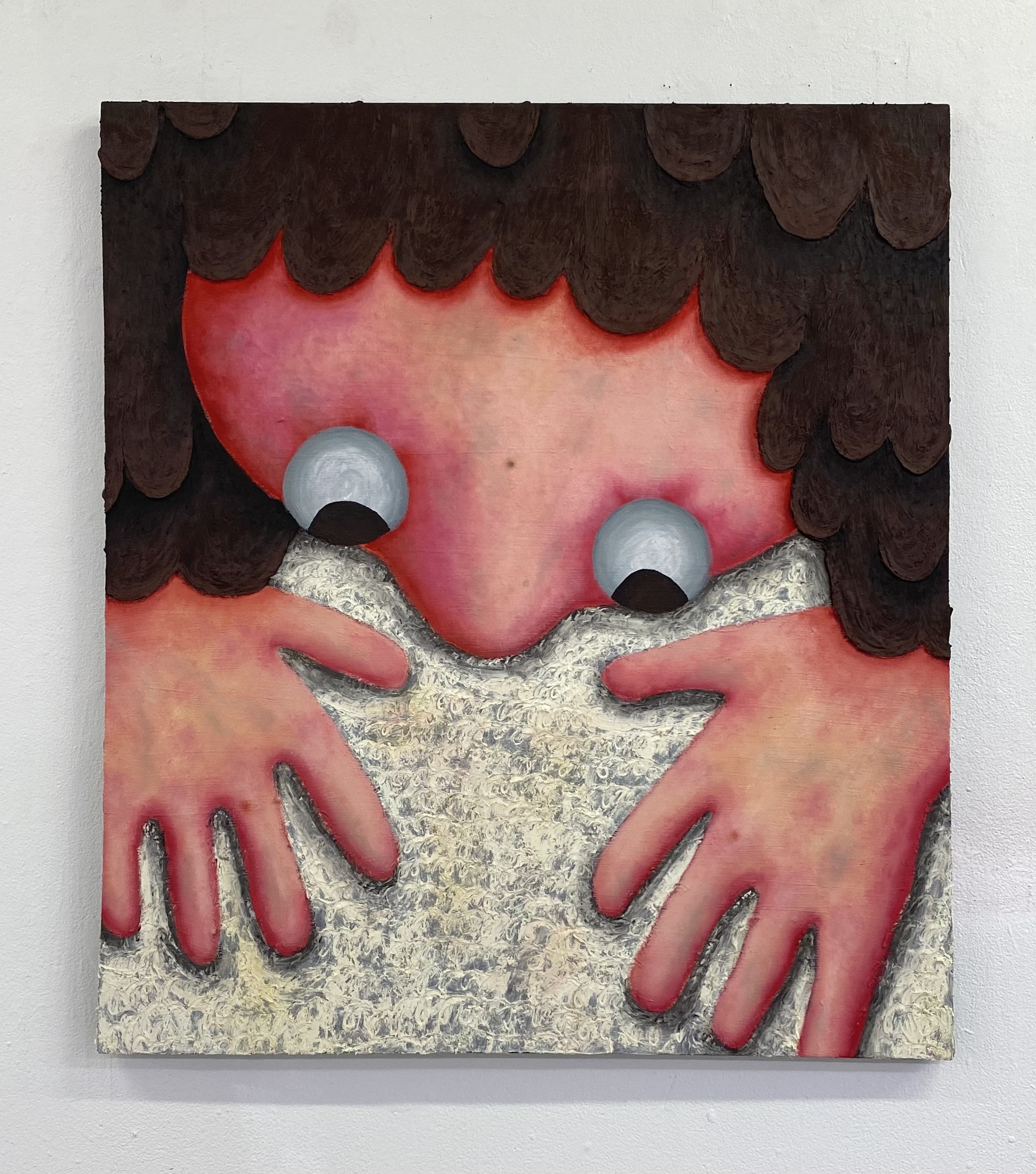
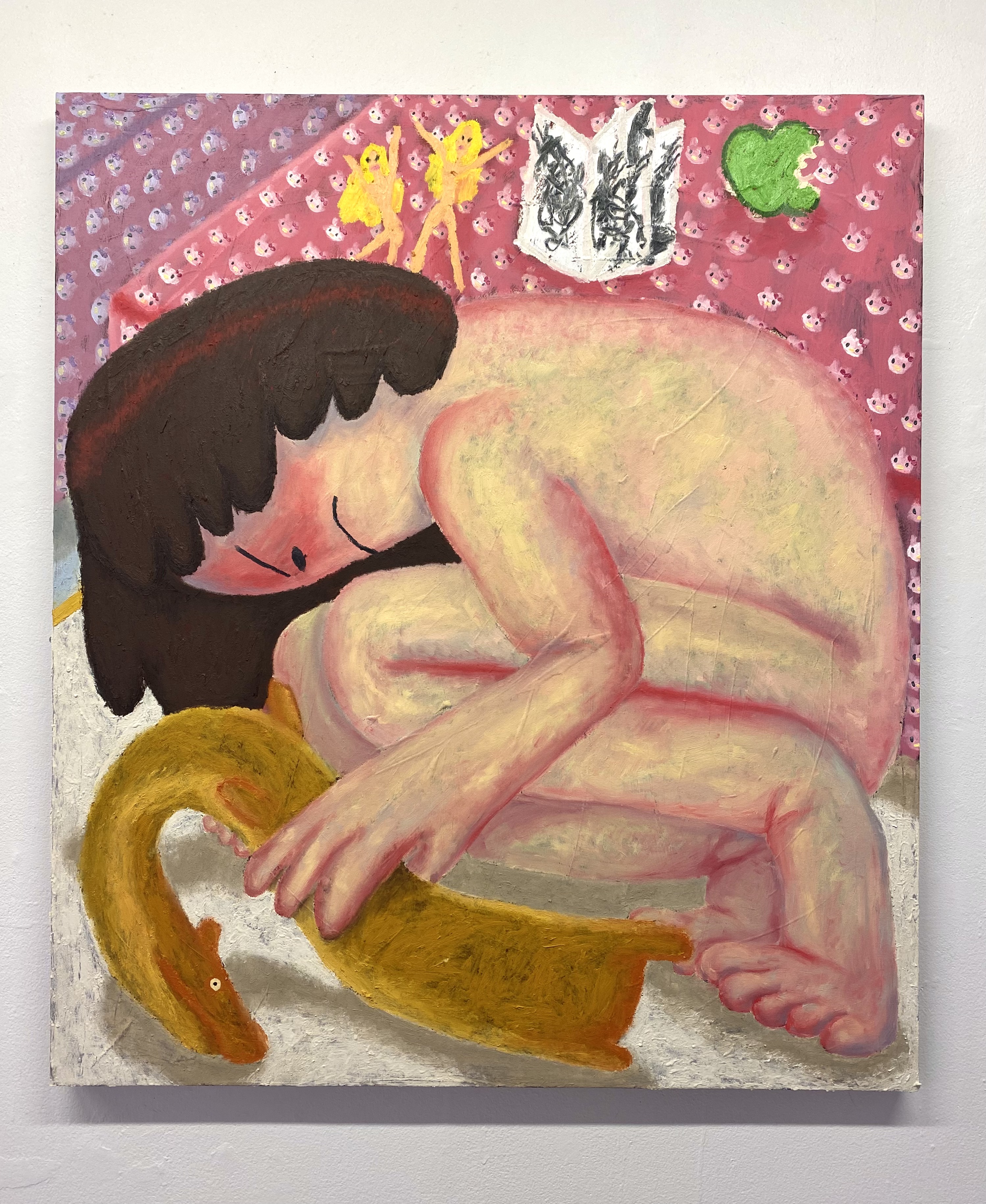
GT: That is so interesting! Would you say your work is a mode in which you can create these alternate realities because we can’t go back and change the past?
AS: I think it is just a big cope for things that I don’t like. I earnestly sometimes believe that they are real and it feels like I’m imagining passing a barrier that I can’t actually access.
GT: You have been talking a lot about identity, what relationship does identity play in your work?
AS: Sometimes I feel identity-less. Like… I am a girl making art about being a girl. I just am hesitant sometimes to fall into the category of being a feminist artist because I myself am a feminist but are the paintings feminist? I don’t know… the paintings are man-obsessed, tradition-obsessed, and obsessed with gender roles. My paintings are definitely girl-coded but I really try to make them sexless.
AS: I think it is just a big cope for things that I don’t like. I earnestly sometimes believe that they are real and it feels like I’m imagining passing a barrier that I can’t actually access.
GT: You have been talking a lot about identity, what relationship does identity play in your work?
AS: Sometimes I feel identity-less. Like… I am a girl making art about being a girl. I just am hesitant sometimes to fall into the category of being a feminist artist because I myself am a feminist but are the paintings feminist? I don’t know… the paintings are man-obsessed, tradition-obsessed, and obsessed with gender roles. My paintings are definitely girl-coded but I really try to make them sexless.

GT: You mentioned the use of minks in your work and how you continually keep circling back to them. How do you find new ways to approach the same subjects and what keeps you inspired in doing so?
AS: They have been becoming very “thing” and “object” as opposed to image. Thematically, they have become more abstract. I keep on making them and I keep becoming a little more bored so I have recently started making plush canvases with googly eyes. I think of them as babies, and in that, it is a little guy that is brought into the world and he is kind of purposeless and can only look at things. I relate it a lot to pareidolia—which is the human tendency to find faces in anything—and I associate that a lot with motherhood and it all ties in with the urge to create. Also, knowing that you're creating something that is purposeless and meaningless is a horrible cycle, but the moment you create something, you want to love it. It is a biological urge which is out of your control and frightening.
GT: It would be great if you could discuss some of the hallmark materials that you rely on a lot in your practice such as glitter for example.
AS: Glitter is so loaded because it is kind of trashy, it’s kind of girly, it is super super not biodegradable but it is also actually not any better than using acrylic paint, it just looks way trashier and it is a more loaded material to use. By loaded, I mean, people don’t like it for its real plastic connotation that it has. …I love glitter, I'm obsessed with glitter. It is so anthropocene and so of the twenty-first-century and is reflective of and a part of something that will probably kill us. And creating anything in an uncertain future is a weird position to be in. It feels weird to be an artist because—in a way—it is very self-obsessive. The glitter babies are a cheeky, asshole-form of an apology to say “Oh, sorry for painting but I’m going to keep doing it” [Laughs].
AS: They have been becoming very “thing” and “object” as opposed to image. Thematically, they have become more abstract. I keep on making them and I keep becoming a little more bored so I have recently started making plush canvases with googly eyes. I think of them as babies, and in that, it is a little guy that is brought into the world and he is kind of purposeless and can only look at things. I relate it a lot to pareidolia—which is the human tendency to find faces in anything—and I associate that a lot with motherhood and it all ties in with the urge to create. Also, knowing that you're creating something that is purposeless and meaningless is a horrible cycle, but the moment you create something, you want to love it. It is a biological urge which is out of your control and frightening.
GT: It would be great if you could discuss some of the hallmark materials that you rely on a lot in your practice such as glitter for example.
AS: Glitter is so loaded because it is kind of trashy, it’s kind of girly, it is super super not biodegradable but it is also actually not any better than using acrylic paint, it just looks way trashier and it is a more loaded material to use. By loaded, I mean, people don’t like it for its real plastic connotation that it has. …I love glitter, I'm obsessed with glitter. It is so anthropocene and so of the twenty-first-century and is reflective of and a part of something that will probably kill us. And creating anything in an uncertain future is a weird position to be in. It feels weird to be an artist because—in a way—it is very self-obsessive. The glitter babies are a cheeky, asshole-form of an apology to say “Oh, sorry for painting but I’m going to keep doing it” [Laughs].
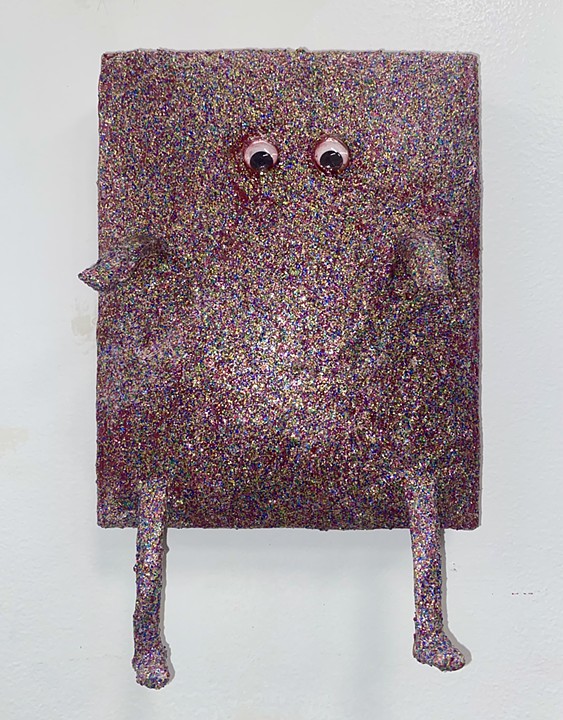
GT: I love that! Who are some of your current inspirations?
AS: That is tricky, I’d say a lot of the classic ones that were formative like Philip Guston, Dana Schutz, and Nicole Eisenman. I like that form of contemporary image, like cartoons, and I think Guston is an interesting one because they are political cartoons and it feels like cartoons are an unclassy form of painting that I find inspiring.
I am also really into semiotics and symbolism, yet I am also aware of the stupidity of symbology because it feels like you are convoluting a point for no reason or just for poetics. I do not want my work to be an eye-spy type of thing. My work is not formal by any means, they are driven by language and outside-thought. I don’t think you can get everything you want out of what I’m making in a vacuum. I want the work to be legible, I want you to see and know what you’re looking at. And I want my symbols to mean a lot of different things because I don’t want them to be closed off, so I try not to talk about them too literally. The symbols are jumping-off-points, but they are also kind of funny. I don’t want my work to feel like something you can just walk past because I want people to engage with it… because some work is hard to enter.
AS: That is tricky, I’d say a lot of the classic ones that were formative like Philip Guston, Dana Schutz, and Nicole Eisenman. I like that form of contemporary image, like cartoons, and I think Guston is an interesting one because they are political cartoons and it feels like cartoons are an unclassy form of painting that I find inspiring.
I am also really into semiotics and symbolism, yet I am also aware of the stupidity of symbology because it feels like you are convoluting a point for no reason or just for poetics. I do not want my work to be an eye-spy type of thing. My work is not formal by any means, they are driven by language and outside-thought. I don’t think you can get everything you want out of what I’m making in a vacuum. I want the work to be legible, I want you to see and know what you’re looking at. And I want my symbols to mean a lot of different things because I don’t want them to be closed off, so I try not to talk about them too literally. The symbols are jumping-off-points, but they are also kind of funny. I don’t want my work to feel like something you can just walk past because I want people to engage with it… because some work is hard to enter.
GT: You mentioned that you grew up with a creative force in you from as far back as you can remember, how has being a student at the School of the Arts Institute impacted your practice or made you realize anything new?
AS: I would say that I am formally or technically a better painter now. I have kind-of always had the same ideas but the more you make something, the more it all plays into each other. I found things getting more abstract and looser, but when I am making a lot of paintings next to each other, they all talk to each other and they don’t need the meaning all condensed into one thing. My paintings are all thought-fragments and when you put them together, they speak a full sentence.
AS: I would say that I am formally or technically a better painter now. I have kind-of always had the same ideas but the more you make something, the more it all plays into each other. I found things getting more abstract and looser, but when I am making a lot of paintings next to each other, they all talk to each other and they don’t need the meaning all condensed into one thing. My paintings are all thought-fragments and when you put them together, they speak a full sentence.

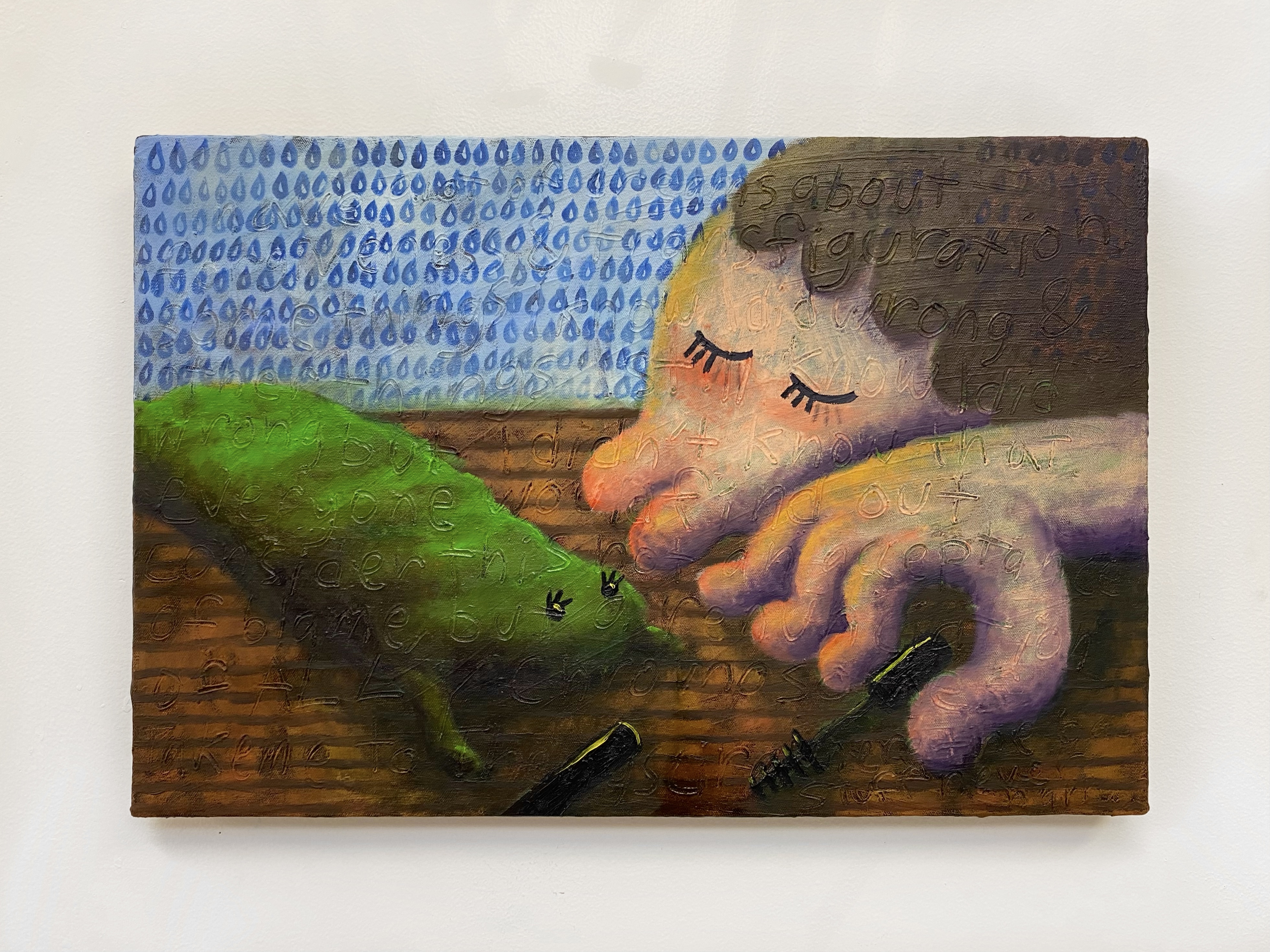
GT: So, would you say you are working to achieve narrative-like serieses in your work?
AS: Yeah, and things tend to transform and I can look back on one of the paintings and think it is really bad… but that was when that idea started and I am still working on it now because it all has the same core. I feel like it is always the same sketch that is just painted differently or the texture is different. I want them to be good paintings and if I didn’t care about making good art, I would just write a manifesto [Laughs]. I want them to be beautiful and intriguing.
GT: At the moment, what has been a motivating force for you? What gets you out of creative ruts?
AS: Oh god [Laughs]. I feel that there are two different modes of artistic creation, because there is you actively making the work… and then there is a ‘passive you’ that is thinking. I feel like I need to do a lot of stewing in order to get stuff out, and then I get it all out. I don’t love what I’m making when I am only making stuff. I need to be thinking about it, otherwise I wasted paint on work that is already dead. I have found myself doing that this year because I have been working too much and not thinking enough and have been obsessed with output. I’ve made some duds that will never see the light of day [Laughs] because I just started making a thing and didn’t think about it at all. This might be controversial, but I think there are two types of art; there is the kind that happens before you start and the kind that happens while you’re painting—formal abstract expressionist-y stuff. I don’t feel that I make good work when I’m working like that, because I need to map and plan so I’m making something worthwhile, but that’s just the way I feel. I don’t feel like I am getting my feelings out through the process of painting, I am just kind of cycling. I will put emotions down on the paper but I am still keeping my feelings in.
I actually do a lot of writing to just distill my thoughts and figure out how to put that into painting. Sometimes my titles get really long because I have a hard time parting with the writing. Now, I am trying not to do that so much so as to get as much as I can from the writing into the painting. It’s tricky, because I don’t want them to be illustrations of a poem because I do think the titles can change it. I don’t want the titles to overpower—or be the work—to the point of overshadowing the paint. There is a lot of writing, and not as much sketching as you would think, just mostly writing. I usually will watch a ton of movies, but not for the past couple of months though and that is something I need to get back into.
AS: Yeah, and things tend to transform and I can look back on one of the paintings and think it is really bad… but that was when that idea started and I am still working on it now because it all has the same core. I feel like it is always the same sketch that is just painted differently or the texture is different. I want them to be good paintings and if I didn’t care about making good art, I would just write a manifesto [Laughs]. I want them to be beautiful and intriguing.
GT: At the moment, what has been a motivating force for you? What gets you out of creative ruts?
AS: Oh god [Laughs]. I feel that there are two different modes of artistic creation, because there is you actively making the work… and then there is a ‘passive you’ that is thinking. I feel like I need to do a lot of stewing in order to get stuff out, and then I get it all out. I don’t love what I’m making when I am only making stuff. I need to be thinking about it, otherwise I wasted paint on work that is already dead. I have found myself doing that this year because I have been working too much and not thinking enough and have been obsessed with output. I’ve made some duds that will never see the light of day [Laughs] because I just started making a thing and didn’t think about it at all. This might be controversial, but I think there are two types of art; there is the kind that happens before you start and the kind that happens while you’re painting—formal abstract expressionist-y stuff. I don’t feel that I make good work when I’m working like that, because I need to map and plan so I’m making something worthwhile, but that’s just the way I feel. I don’t feel like I am getting my feelings out through the process of painting, I am just kind of cycling. I will put emotions down on the paper but I am still keeping my feelings in.
I actually do a lot of writing to just distill my thoughts and figure out how to put that into painting. Sometimes my titles get really long because I have a hard time parting with the writing. Now, I am trying not to do that so much so as to get as much as I can from the writing into the painting. It’s tricky, because I don’t want them to be illustrations of a poem because I do think the titles can change it. I don’t want the titles to overpower—or be the work—to the point of overshadowing the paint. There is a lot of writing, and not as much sketching as you would think, just mostly writing. I usually will watch a ton of movies, but not for the past couple of months though and that is something I need to get back into.

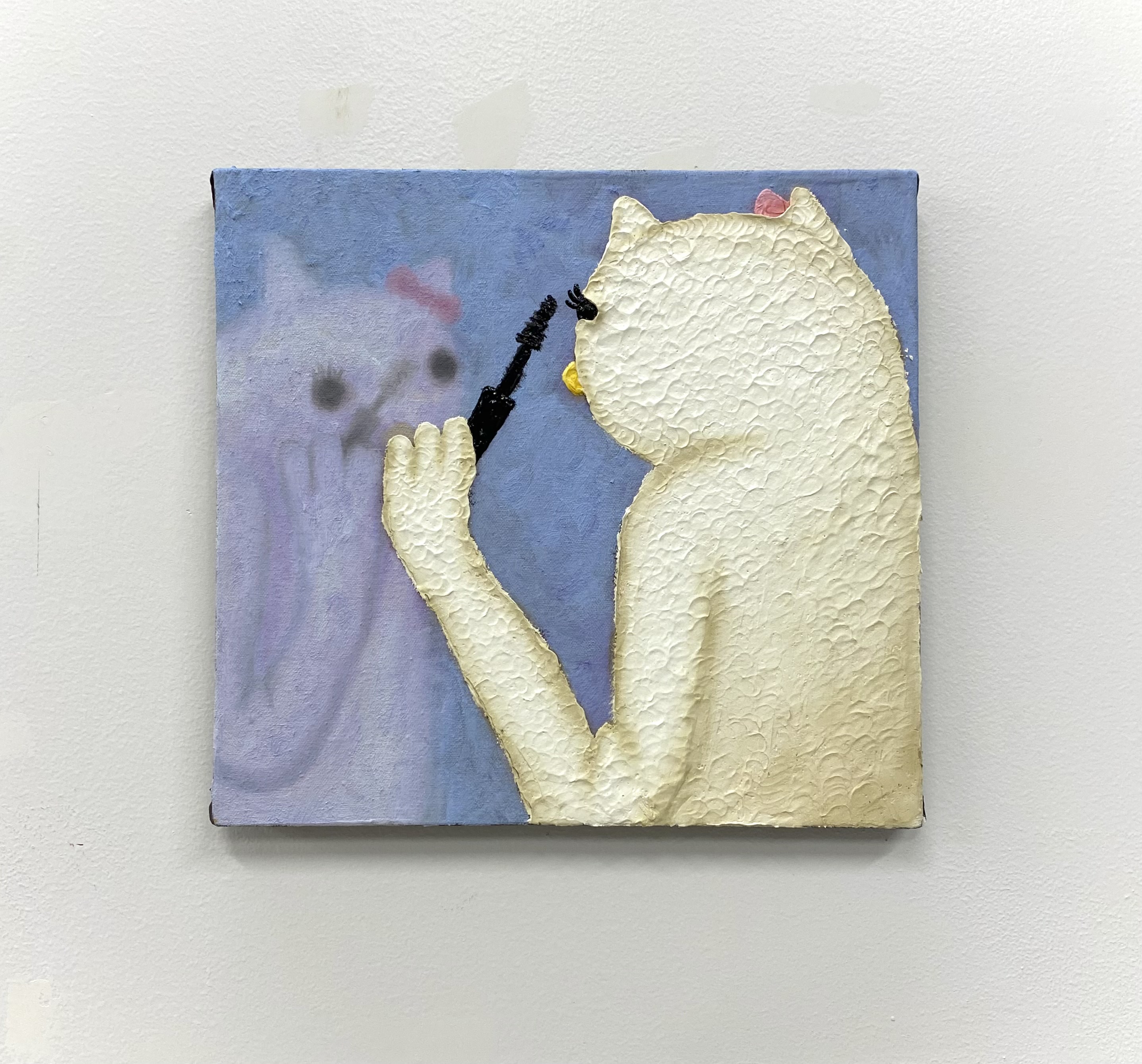
GT: What is something that you are looking forward to either in terms of the arts or anything in general?
AS: I am excited to go home for Christmas and see my family back in Los Angeles. I really enjoy living here in Chicago though and have been here for three years. I like that I don’t have to drive and the buildings make the city seem so tall in comparison to the flatness of LA.
GT: Have you noticed any differences between the art scene in Los Angeles compared to here in Chicago?
AS: I don’t really feel like I can say I was a part of the LA art scene because the barrier of entry there is much higher and I was younger when I lived there. Here in Chicago, there is a big DIY scene and lots of apartment shows. Even the big corporate galleries feel accessible. It never feels like the ceilings ever need to be that high in Chicago compared to Los Angeles. LA shows are super white-walled and super duper sterile. Even the most sterile gallery here would not be as hard to enter as if it was in LA. Maybe it’s just that midwestern hospitality… and I love Chicago because it is a big city but the people are nice [Laughs]. And the people in LA are all so hot [Laughs] and it feels like they are selling themselves as much as they are selling their art. I don’t have a ton of myself that I want to sell. I want to sell the art, not-so-much myself as an influencer or a personality.
GT: What is one thing you would like to accomplish next year?
AS: I want a series, but I also want to work a little less and think a little bit more. I feel like I have been engaging in too much output and not enough consumption. Like, it kind of frightened me when you asked ‘who are my inspirations’ because I don’t know if I really have any right at this moment. I am in my own little echo-chamber where I get inspired by myself and it gets distilled into the most Ashley thing that has existed. So, when I try to decide when a work is done, sometimes I don’t know, because I am so self-involved right now. Maybe I need to look out, I have been going to art shows… but this is just where I’m at right now.
GT: This has been wonderful, thank you!
AS: Of course, yes, thank you.
AS: I am excited to go home for Christmas and see my family back in Los Angeles. I really enjoy living here in Chicago though and have been here for three years. I like that I don’t have to drive and the buildings make the city seem so tall in comparison to the flatness of LA.
GT: Have you noticed any differences between the art scene in Los Angeles compared to here in Chicago?
AS: I don’t really feel like I can say I was a part of the LA art scene because the barrier of entry there is much higher and I was younger when I lived there. Here in Chicago, there is a big DIY scene and lots of apartment shows. Even the big corporate galleries feel accessible. It never feels like the ceilings ever need to be that high in Chicago compared to Los Angeles. LA shows are super white-walled and super duper sterile. Even the most sterile gallery here would not be as hard to enter as if it was in LA. Maybe it’s just that midwestern hospitality… and I love Chicago because it is a big city but the people are nice [Laughs]. And the people in LA are all so hot [Laughs] and it feels like they are selling themselves as much as they are selling their art. I don’t have a ton of myself that I want to sell. I want to sell the art, not-so-much myself as an influencer or a personality.
GT: What is one thing you would like to accomplish next year?
AS: I want a series, but I also want to work a little less and think a little bit more. I feel like I have been engaging in too much output and not enough consumption. Like, it kind of frightened me when you asked ‘who are my inspirations’ because I don’t know if I really have any right at this moment. I am in my own little echo-chamber where I get inspired by myself and it gets distilled into the most Ashley thing that has existed. So, when I try to decide when a work is done, sometimes I don’t know, because I am so self-involved right now. Maybe I need to look out, I have been going to art shows… but this is just where I’m at right now.
GT: This has been wonderful, thank you!
AS: Of course, yes, thank you.


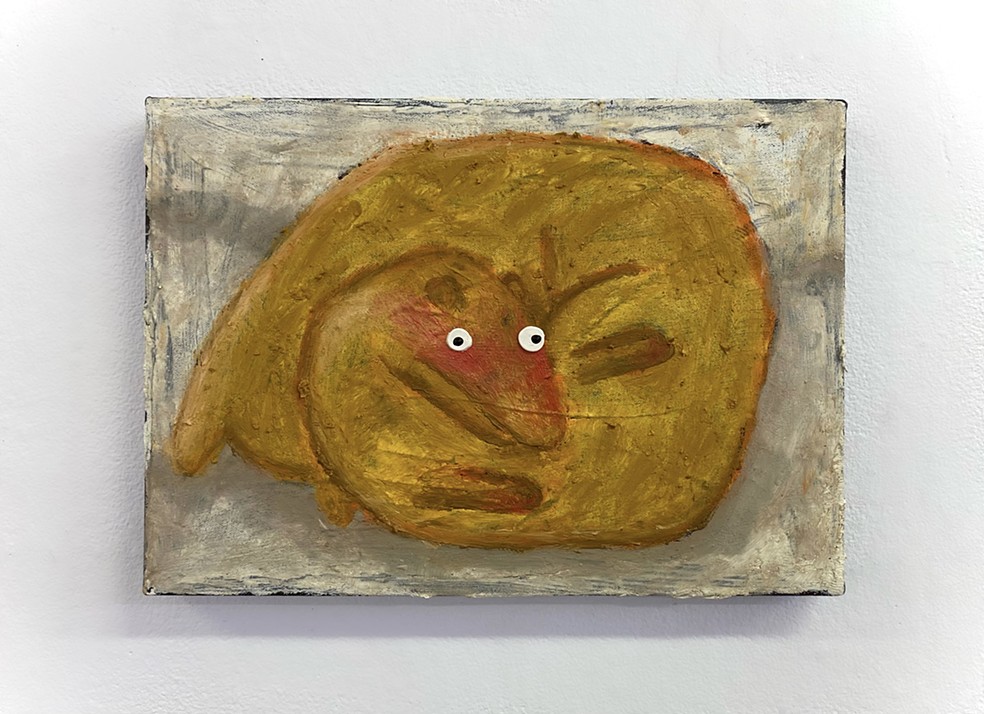
Ashley’s website: https://ashleystokols.com/home.html.